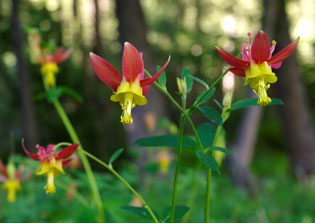Western Red Columbine in the Landscape

Stephen Love, University of Idaho
Scientfic Name: Aquilegia formosaCommon Name: Western Red Columbine
Description: Western red columbine is an herbaceous, very long-lived perennial. The plants die back to the ground during winter and new shoots emerge from a cluster of fleshy crowns and develop into a dense clump of attractive, divided leaves in early spring. A short time later, several branched flower stems rise high above the foliage and produce intricate, spurred red and yellow flowers. Bloom period is four to six weeks in late May into July. Bloom is enhanced with adequate moisture availability. Western red columbine grows best in dappled shade, but withstands a wide range of sun conditions. This species is a good subject for shady beds and borders among taller forbs and shrubs.
Native Habitat: Western red columbine is native to the northern Rocky Mountain states, Nevada, and California. Its primary habitat is seasonally moist thickets and open groves, although it can be found in alpine areas near treeline. It can be found growing among aspen, fir, and mixed forbs and grass over a wide elevation range of 4,000 to 10,000 feet.
Cultural Requirement
Soil: Adapted to a range of soils, including those with high pH. Does well in heavier soil with higher moisture-holding capacities but can also thrive in well-drained sandy or gravelly substrates.
Moisture Tolerance: In spite of its origins, this species can survive and bloom in moderately xeric conditions. However, it does bloom longer and more profusely if given routine supplemental irrigation.
Sun/Shade/Preference: Thrives in a range of light exposures from full sun to shade.
Transplanting: Transplants well, both from pot to pot and from pot to garden. Plants develop rapidly and do well in pots of any common size.
Propagation: Easy from seed. Requires a long period of cold stratification (10-12 weeks) for best germination. Can be easily propagated using crown cuttings or crown division.
Maintenance (pruning, fertilization, deadheading, division, irrigation, etc): Remove the flower stems at the end of spring bloom. If the leaves become senescent and unattractive in late summer, cut them back to the crown to encourage new leaves. Consistent supplemental irrigation is needed (every 8 to 15 days during mid-summer) to prolong bloom and extend the attractive stages of growth. Occasional fertilization is needed, as plants demand.
Insect, disease, or other problems: Spider mites and powdery mildew are common problems on most columbine species, including western red columbine. Both problems can be controlled with applications of pesticides, but it may be preferable to simply cut back the old, damaged foliage and allow younger, more tolerant leaves to take their place.
Landscape Value
Use in the Landscape: Western red columbine is an upright, moderately tall plant when in flower. It has the ability to grow and bloom in dense plantings and moderate shade. This makes it valuable for adding color to areas in the landscape dominated by woody plants. It also enhances the spring appearance of almost any berm, bed, or border. It is amenable to either formal or naturalized designs and can be incorporated almost anywhere.
Foliage: The leaf-bearing stems remain short and produce a dense mound of light green, divided leaves.
Flower: Sparsely branched flowering stems extend vertically from the foliage and produce flowers that, compared to many species, tend to be short-spurred and narrow-faced. The flowers grow on long, arched stems and tend to face downward. Flower color is a combination of yellow and various shades of red to red-orange.
Timing: May, June, July
Color: Red/yellow, red-orange/yellow.
Fruit: The fruit is a follicle; a dry, papery, capsule-like structure born at the ends of the flowering stems. Each follicle contains numerous seeds.
Form: Mounded in the foliar phase, upright and vertical in bloom.
Texture: Moderately fine.
Ultimate Size: Out of bloom - 7 to10 inches; in bloom varies by provenance, 18 to 40 inches. Width is 12 to 18 inches.
Rate of Growth: The foliage develops rapidly. The plants seldom bloom the first year, but the foliage grows rapidly and quickly becomes attractive
Suggested Plant Partners: Western red columbine enhances tree and shrub beds and looks good with Populus tremuloides, Philadelphus lewisii, Cornus sericea, and Rhus glabra. Other good partners include small to moderate-sized, non-xeric clump grasses such as Sporobolus airoides or Deschampsia caespitosa and wildflowers such as Penstemon rydbergii, Delphinium geranifolium, and Erigeron glaucus.
Availability: Moderately easy to find as a potted plant at local or mail order native plant nurseries. Seed can be purchased from many native plant seed suppliers.
Cultivars: Aquilegia formosa is often used as a parent in creating columbine hybrids, but no named cultivars of the species are available.
References:
USDA Plant Database

